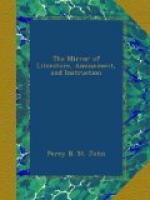Simond says, “after passing several falls of water, each of which we mistook for the Staubbach, we came at last to the house where we were to sleep. It had taken us three hours to come thus far; in twenty minutes more we reached the heap of rubbish accumulated by degrees at the foot of the Staubbach; its waters descending from the height of the Pletschberg, form in their course several mighty cataracts, and the last but one is said to be the finest; but is not readily accessible, nor seen at all from the valley. The fall of the Staubbach, about eight hundred feet in height, wholly detached from the rock, is reduced into vapour long before it reaches the ground; the water and the vapour undulating through the air with more grace and elegance than sublimity. While amusing ourselves with watching the singular appearance of rockets of water shooting down into the dense cloud of vapour below, we were joined by some country girls, who gave us a concert of three voices, pitched excessively high, and more like the vibrations of metal or glass than the human voice, but in perfect harmony, and although painful in some degree, yet very fine. In winter an immense accumulation of ice takes place at the foot of the Fall, sometimes as much as three hundred feet broad, with two enormous icy stalactites hanging down over it. When heat returns, the falling waters hollow out cavernous channels through the mass, the effect of which is said to be very fine; this, no doubt, is the proper season to see the Staubbach to most advantage.” Six or eight miles further, the valley ends in glaciers scarcely practicable for chamois hunters. About forty years since some miners who belonged to the Valais, and were at work at Lauterbrun, undertook to cross over to their own country, simply to hear mass on a Sunday. They traversed the level top of the glacier in three hours; then descended, amidst the greatest dangers, its broken slope into the Valais, and returned the day after by the same way; but no one else has since ventured on the dangerous enterprise.
Apart from the romantic attraction of the Fall, the broad-eaved chalet and its accessaries form a truly interesting picture of village simplicity and repose. Here you are deemed rich with a capital of three hundred pounds. All that is not made in the country, or of its growth, is deemed luxury: a silver chain here as at Berne, is transmitted from mother to daughter. Dwellings and barns covered with tiles, and windows with large panes of glass, give to the owner a reputation of wealth; and if the outside walls are adorned with paintings, and passages of Scripture are inscribed on the front of the house, the owner ranks at once among the aristocracy of the country. What an association of primitive happiness do these humble attributes and characteristics of Swiss scenery convey to the unambitious mind. Think of this, ye who regard palaces as symbols of true enjoyment! and ye who imprison yourselves in overgrown cities, and wear the silken fetters of wealth and pride!—an aristocrat of Lauterbrun eclipses all your splendour, and a poor Swiss cottager in his humble chalet, is richer than the wealthiest of you—for he is content.




